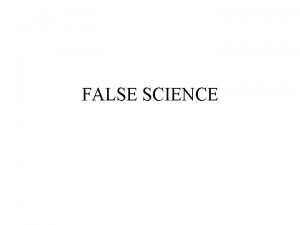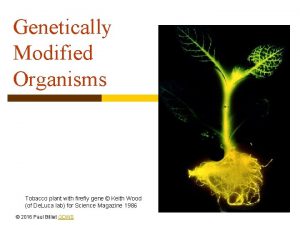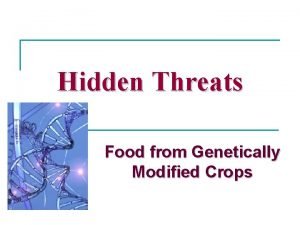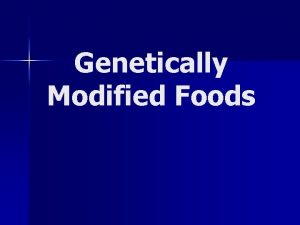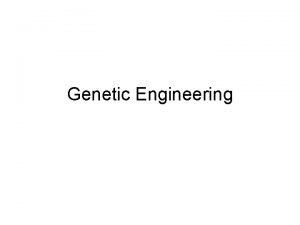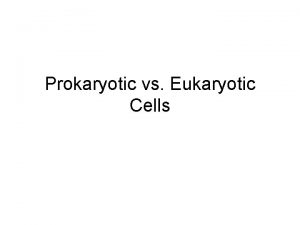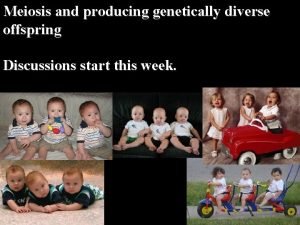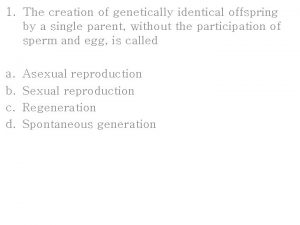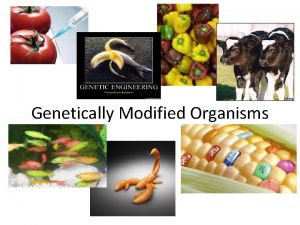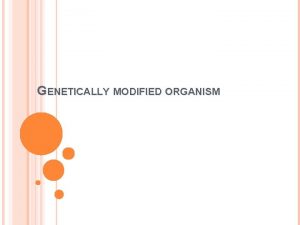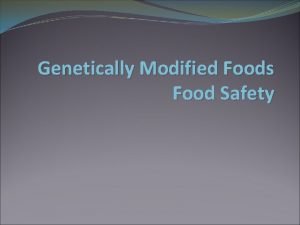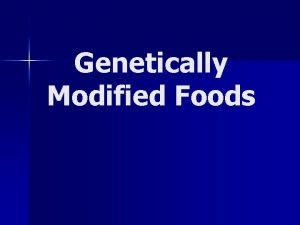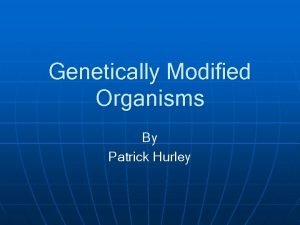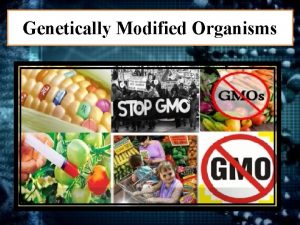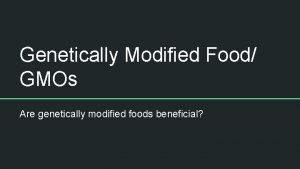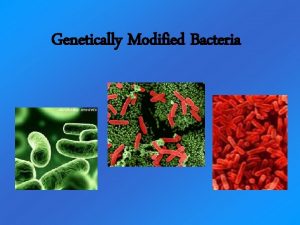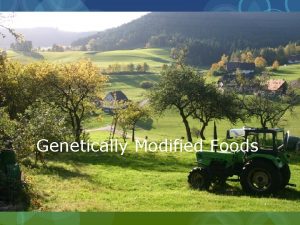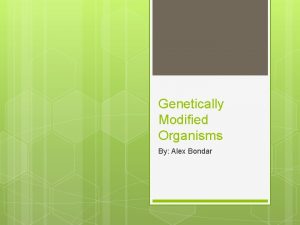A genetically modified organism is an organism whose













- Slides: 13


A genetically modified organism is an organism whose genetic material has been altered using genetic engineering techniques. There is controversy over GMOs, especially with regard to their use in producing food. The key areas of controversy related to GMO food are whether GM food should be labeled or not, the role of government regulators, the effect of GM crops on health and on the environment, the effect on pesticide resistance and the role of GM crops in feeding the world population. Based on a comprehensive decision making process, the EU and the member states are of the opinion that the product must be safe and can not post threats to human or animal health. It also must be safe for the environment. All products from GMOs must be considered just as safe as their conventionally derived counterparts. If this is not the case, the GMO will not receive authorization.

• When Romania became an EU member state, in 2007, the cultivation of GM soya in Romanian territory was officially banned, in the sense that Romania agreed to only cultivate the GMOs authorized in the EU. The GM soya was not authorized for cultivation on EU territory, being considered economically unfeasible. However, in April 2007, a GM corn named MON 810 (owned by the same Monsanto Company) was approved for cultivation in Romania. This was the only GMO authorized in the EU and Romania automatically authorized it. No assessment studies have been conducted regarding the environmental effects of GM corn in Romania. • The EU s legislation and policy on GMO’s is designed to prevent any adverse effects on the environment and the health of humans and animals. The Romanian GMO legislation is the product of a rushed harmonization of the national regulation with the European directives. Romania has 27 laws in this field, the country with the most laws in this field, which regulates the GMO in a complicated manner leaving room for interpretation. Many of these laws were never submitted to public debates. For example, Law no. 1829, from January 2007, Approved the environmental risk and human health assessment. • An even more critical aspect of the GMO legislation is its application. A real example is the way Romania banned GM soya. The efforts to remove these GM crops from the fields were superficial and irresponsible. More than that, The National Registry of the GMO from 2006 and various responsed to requests for information from 2006 to 2010 shows that the authorities didn’t have any control on the cultivation of GM soya even when it was authorized in Romania.

q The Romanian regulations require the labeling of genetically modified products since june, 2006 (Law no. 106/2002 – the provisions regarding GMOs being completed by the Governmental Decision no. 173/2006). q. Currently there isn’t any food on the Romanian market, which is labeled as genetically modified or as having GM ingredients. q Romanian consumers are deprived of the right to choose between genetically modified and nonmodified products from the shelves of the stores. q They can't identify what kind of product they buy by simply consulting the label. Also, there aren’t any public results of laboratory analysis of any products made by the authorities. q Romania doesn’t have any conducted or published studies on examining the impact of GM crops on the environment and human health and there aren’t any plans to achieve such studies in the

Am I Eating GMOs? If you live in Romania, you are most likely eating GMOs and/or livestock who were fed with GMO's. Eighty-eight percent of the corn grown in Romania has been genetically modified to be herbicide-resistant and/or insect-resistant. Below are just some examples of the long list of disadvantages of such practice: 1. The safety of such products is not verified yet, in fact, we are the lab rats to test the safety of such technology! This is sad, but true. In fact, genetically engineered food is being consumed daily with no thorough research of its potential threats on human health. 2. Genetically modified ingredients can cause cancer! A consultant histopathologent at Aberdeen Royal Infirmary, Dr. Stanley Ewen, raised the concern that food and water contaminated with genetically engineered material could increase the growth of malignant tumours upon contact with humans. Later, other studies suggested a link between engineered food and cancer. 3. It could raise new allergy outbreaks in humans! It was found that a genetically engineered soya bean containing Brazilian nut protein was allergenic to humans and was withdrawn from production. 4. You are ''not'' what you eat anymore! Genetic engineering allows introducing animal products in plants which could raise issues for those with dietary restrictions, like vegetarians

GM foods have been among us for decades, and it seems they are only growing in number. These are some of the top offenders that unless otherwise labeled, will most likely contain GMOs of some sort. What is most alarming is that these are the products we eat daily, unaware of the danger we are putting ourselves in. 1. Corn is the largest crop grown in Europe and some of the biggest providers have altered them so they’ll grow better. GM corn has been engineered to that it will ward off insects and battle back against herbicides. These are not the kind of chemicals you would want to put in your body knowingly. There is only one way to avoid it and that is organic corn, a bit pricier but, as we know, health is expensive. 2. Tomatoes often make news headlines for their healthy benefits, but they are equally dangerous if GM. The benefits of natural tomatoes are completely compromised, especially the ability to prevent cancer, when they contain herbicides and pesticides. Fortunately, although they are becoming more rare, non-GM tomatoes can still be found. 3. Potatoes The favourite food of everyone, potatoes are grown in abundance all over the world. What turns these into our number one health enemy is the enormous quantity of pesticides and herbicides they are treated with. Potatoes are also the ones that are found nowadays very rarely in organic form and that is why it is recommended to make your own at home. 4. Conventional meat and milk Because cows, chickens and other animals we eat are now being fed unnatural diets, they become a sure source of GMOs. Conventional milking cows are pumped full of antibiotics and other drugs to keep them alive in terrible conditions, thus they are unable to produce healthy milk. You are what you eat but you are also what your food source eats. Buy organic meat and opt for products like almond milk. This not only gives you safe, non-modified food, but it helps you avoid the needless intake of GMOs.





Nowadays, when the problem of environmental protection is quite stringent, the producers are concerned to bring on the market products, which have reduced environmental impact. In their turn, the consumers have become more aware and selective in purchasing products or services. Due to the financial crisis, consumers buy less but they are asking for quality and environmental friendly products. Under these circumstances the producers must find solutions in order to satisfy the consumers' requirements. According to market survey the significant progress has been made in the production of green products so that they reduce the environmental impact, taking into account a part or the whole lifecycle of the product.

• One of the most important and successful certification schemes identified by survey is the European eco-label. However, there a number of other widely accepted and successful labels that are also analyzed in the present study. • The survey objective was to identify green products on the Romanian market and to monitor their evolution. The present paper presents the results of three years market research focusing on product categories that include ecolabeled products.

THE END XI-G Hapaina Antonia Mergea Adina Petruța Emilia Popescu Vanessa Popescu Andrei Teacher : Popescu Silvia
 Kayla slater
Kayla slater Pleiotrophy
Pleiotrophy Gmos advantages and disadvantages
Gmos advantages and disadvantages Tobacco plant expressing firefly gene
Tobacco plant expressing firefly gene Genetically modified organisms
Genetically modified organisms Genetically modified crops have
Genetically modified crops have Genetically modified food
Genetically modified food Genetically modified organisms
Genetically modified organisms Genetically modified crops have
Genetically modified crops have Organism cells
Organism cells Yellowstone food web answer key
Yellowstone food web answer key Diverse offspring
Diverse offspring The creation of genetically identical offspring
The creation of genetically identical offspring Chapter 22 genetics and genetically linked diseases
Chapter 22 genetics and genetically linked diseases

